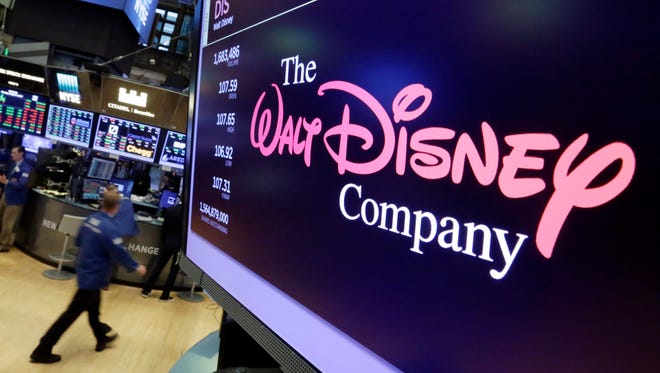Sweet streams, all these streaming plans, plus Disney, could wind up costing you more
 Mike Snider
Mike Snider
Disney's plan to launch a broadband-delivered video service featuring its new theatrical films — and the likelihood other media giants will follow suit — could actually result in consumers paying more for the content they want to watch.
The content powerhouse — it owns Pixar, LucasFilm and Marvel as well as its own animation and live-action studio — did not say how much it would charge for its direct-to-consumer subscription service when it arrives in 2019. Or how much it would charge for its ESPN-branded sports service, due to launch in early 2018.
But both will join an already-crowded marketplace of subscription streaming services delivered via the Net. In addition to broadband pay-TV services such as DirecTV Now and Sling TV that deliver "skinny" bundles, there's Netflix, Amazon Video, Hulu, HBO Go, Showtime, CBS and others. And Discovery's acquisition of Scripps Networks (The Food Network, HGTV) suggests a similar direct-to-consumer strategy is in the works.
"What gets incrementally harder here is just the array of choices, and that is only going to grow," said Matthew Thornton, analyst with investment banking firm SunTrust Robinson Humphrey. "You are going to see more of this, and the consumer has to start figuring out … I am trying to save money, but what does my new bundle look like? it can become overwhelming."
Consumers could easily wind up paying more for their new customized bundle of programming than they did when they subscribed to traditional pay TV, experts say.
Cable, satellite and fiber companies such as AT&T, Comcast, Dish and Verizon currently get about $80 to $85 each month from pay-TV subscribers, according to Leichtman Research.
In contrast, a customer who subscribes to Netflix ($10-$12 monthly) and perhaps HBO ($14.99) and/or Showtime ($10.99) and decides to add the new Disney service — let's say it's $15, comparable to HBO — would have amassed a monthly bill of $36 to $53.
But what about Hulu ($7.99-$11.99 monthly), which has its own exclusive series such as The Handmaid's Tale, and new episodes of broadcast shows such as The Voice and Empire?
And what if you want a sports package such as the new one coming from Disney with more than 10,000 sports events including Major League Baseball, National Hockey League, Major League Soccer, tennis and college sports? You'll likely need to add $10 to your monthly costs. Or say you subscribe to a season package such as MLB.tv for $112.99. That's about $18 over each of the six months or so of the season.
Adding some of these gets you into the $54 to $81 monthly range. Some good news: If you are an Amazon Prime customer ($99 annually), you get its video service for free.
And in addition to that, some cord cutters who have left or eschewed traditional pay-TV for a skinny bundle provider such as DirecTV Now, Sling TV and Sony's PlayStation Vue are also paying $25 to $45 monthly to get live broadcasts of channels including AMC, CNN, CNBC, ESPN, ESPN 2, Fox Sports 1 and FS2, MSNBC, Nickelodeon and others. (Specific offerings depend on the service and tier — some can pay up to $70 for more plentiful bundles.)
Add that to your monthly bill, and it's now $80 or vastly more. Now, envision a near future where you pay $5 to $10 per app for your favorite 10 networks and it "would end up costing me $50 to $100/month — as much or more than I would spend on a multi-channel video service like Comcast or DirecTV Now," said Michael Greeson, analyst with research firm The Diffusion Group.
The onus will be on consumers to make some hard choices in the future, so as to not overpay for programming. Most will want to spend $40 to $70, depending on their consumption and disposable income, Thornton says. "What is the right mix? Is it Netflix plus Amazon plus HBO or is it Disney plus Netflix?"
Families — faced with meeting the desires of multiple viewers — will need to plan accordingly, said Jim Willcox, senior editor at Consumers Report. "What they need to do is sit down and every family member has to say, 'These are the channels I can’t live without,' and then try to find a package that delivers that or you put together your own bundle that can provide that."
Eventually, the TV landscape could shake out into about half of homes subscribing to traditional pay-TV services, with the other half creating their own bundles out of broadband-delivered options, says Michael Nathanson, analyst with research firm Moffett Nathanson. "Some will want to big bundle from traditional distributors, some will settle for less," he said.
Netflix has likely been preparing for Disney's move, he said, and "it will push them to continue to create their own original content so that they can own the rights for all markets. This has been the strategy, and this move by Disney shows why they have done it."
By the time Disney launches, Netflix may not be the top streaming choice that it currently is, says analyst Joel Espelien, also with The Diffusion Group. "If there get to be more services and more slicing up of that overall pie," he said, "arguably Netflix could lose share."
"If these other services get better, you could see people say, I’m an Amazon Prime customer, maybe I like the Hulu skinny bundle and throw HBO on top of that or an ESPN or Disney for sports or kids," Espelien said. "At that point, why would I subscribe to Netflix?"
Shares of Netflix (NFLX) closed Wednesday down 1.4% to $175.78. Disney (DIS) shares fell 4% to $102.78.
More: Stream these 10 Disney movies on Netflix while you can
More:Netflix acquires comic book publisher Millarworld
More:Comcast to offer commercial-free FX add-on with library of cable network series
Follow USA TODAY reporter Mike Snider on Twitter: @MikeSnider.